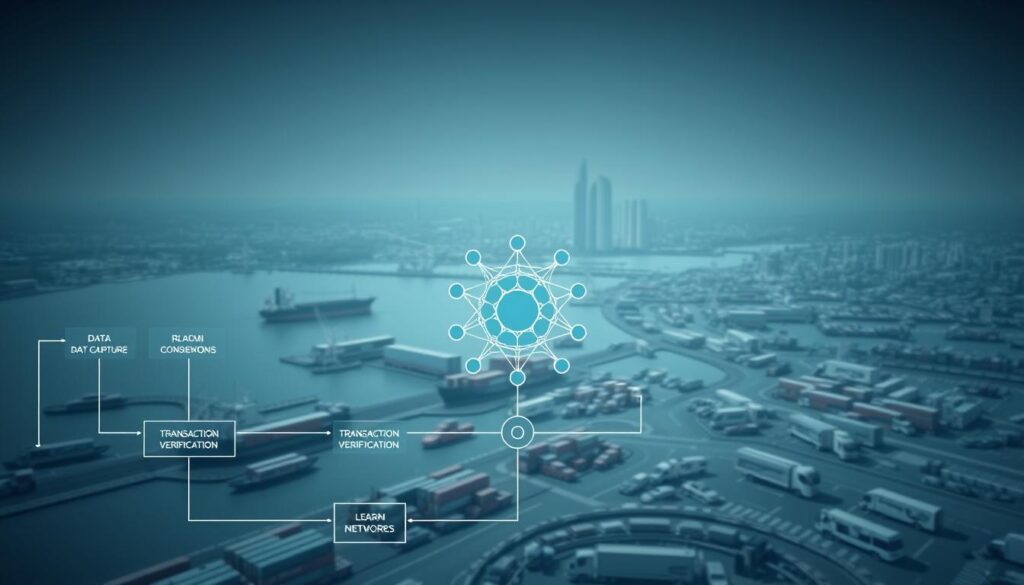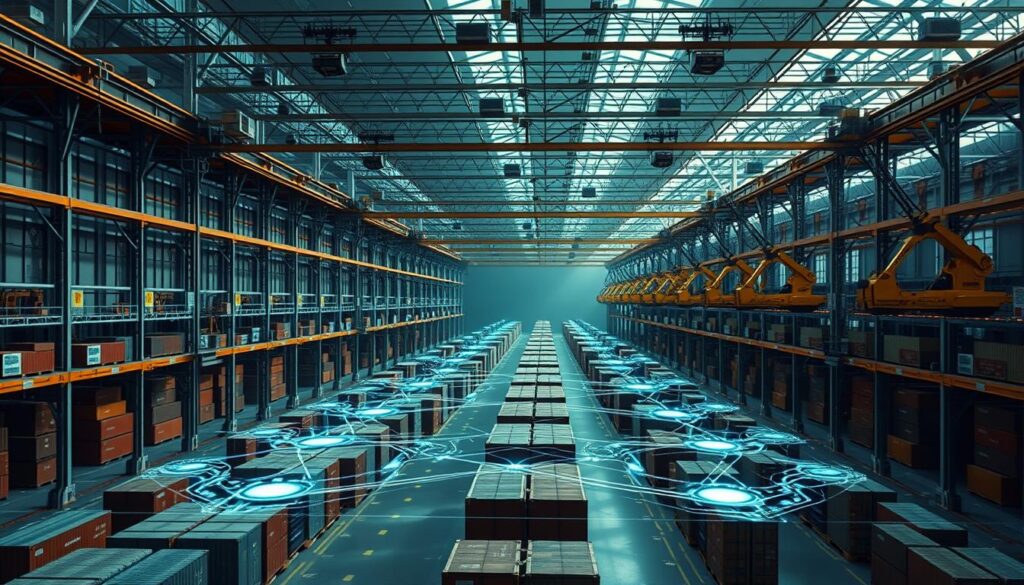Now Reading: Blockchain in Logistics Shipping Tracking: Enhancing Visibility
- 01
Blockchain in Logistics Shipping Tracking: Enhancing Visibility
Blockchain in Logistics Shipping Tracking: Enhancing Visibility
Global trade moves countless goods every day. But the systems managing this flow often struggle. Information gets stuck in silos. Delays in communication create costly problems. Accountability can be difficult to pinpoint across a complex network.
A new kind of digital ledger offers a powerful solution. This technology creates a shared record that everyone in the chain can trust. Its core features include decentralization and immutability. This means no single party controls the data, and records cannot be altered.
This approach brings unprecedented clarity to operations. All authorized participants see the same real-time information. From the origin of a product to its final destination, every step is documented. This creates a single source of truth that enhances trust and efficiency.
The need for such transparency became especially clear during recent global disruptions. Businesses saw how fragile traditional systems can be. Adopting this advanced ledger system is a strategic move toward stronger, more resilient supply chains.
Key Takeaways
- Traditional supply chain management often suffers from information gaps and delays.
- Blockchain technology introduces a decentralized and unchangeable record of transactions.
- All parties in the supply network gain access to the same real-time data.
- This creates a single, trusted source of information from start to finish.
- Enhanced visibility leads to greater accountability and operational efficiency.
- Recent global events have accelerated the adoption of this innovative technology.
Introduction to Blockchain’s Role in Modern Logistics
Modern business ecosystems rely on intricate webs of transactions spanning multiple organizations. Each participant adds value through a series of exchanges involving goods, services, and financial flows.
This interconnected network faces significant challenges with traditional record-keeping methods. Information often gets trapped in isolated systems, creating delays and trust issues.
Overview of Blockchain Technology
A distributed digital ledger offers a revolutionary approach to managing complex networks. This system creates verified blocks of transaction data that form an unchangeable chain.
Each block contains validated information that cannot be altered once recorded. Multiple computers maintain identical copies of the entire history, ensuring transparency and security.
| Traditional Systems | Blockchain Approach | Key Benefits |
|---|---|---|
| Centralized databases | Distributed ledger technology | Enhanced security |
| Separate record-keeping | Shared transaction history | Real-time visibility |
| Manual verification | Automated validation | Reduced errors |
| Limited access control | Permissioned participation | Controlled transparency |
Impact on Supply Chain Management
Permissioned versions of this technology are particularly valuable for business networks. Authorized members can access a single source of truth while maintaining privacy.
The system captures and validates data across interconnected companies efficiently. This addresses traditional challenges like information silos and accountability gaps.
Recent global disruptions highlighted the need for more resilient operational frameworks. This advanced approach integrates with existing enterprise systems rather than replacing them.
Enhancing Visibility Through Transparent Supply Chains
Current commercial distribution systems face significant challenges in maintaining clear oversight of product movements. Information gaps between different organizations create uncertainty and delays.
Advanced digital ledger systems transform this landscape by providing complete end-to-end traceability. Every transaction becomes permanently recorded and accessible to authorized participants.
Benefits of End-to-End Tracking
Complete visibility across the entire distribution network offers substantial advantages. Stakeholders gain real-time insights into product location and status.
This comprehensive oversight enables faster response to disruptions. Decision-makers can proactively address issues before they escalate.
| Traditional Approach | Digital Ledger Solution | Operational Impact |
|---|---|---|
| Delayed status updates | Immediate visibility | Faster problem resolution |
| Separate record systems | Unified data source | Reduced disputes |
| Manual verification | Automated validation | Lower administrative costs |
| Limited access control | Permission-based sharing | Enhanced security |
Real-Time Updates and Data Integrity
Continuous information flow ensures all parties work with identical, current data. This synchronization eliminates confusion and misinterpretation.
The immutable nature of recorded transactions guarantees data integrity. Once entered, information cannot be altered or deleted.
This creates a trusted environment where participants can confidently make decisions. The system builds accountability throughout the entire commercial network.
Practical Guide to Implementing blockchain in logistics shipping tracking
Successful deployment of digital ledger solutions demands a methodical approach that considers both technical and operational factors. This guide outlines key steps for integrating distributed ledger technology into existing commercial networks.
Step-by-Step Implementation Process
Begin with comprehensive stakeholder discussions across your organization and partner networks. Evaluate potential benefits through detailed cost-benefit analysis before committing resources.
Engage IT and cybersecurity teams early in the planning phase. Their expertise ensures technical requirements and security protocols receive proper attention throughout the project lifecycle.

Key Integration Points with Existing Systems
Many companies operate legacy software that may not directly connect with distributed ledger platforms. Identify critical touchpoints where new solutions can interface with current systems.
Focus on enterprise resource planning platforms, warehouse management tools, and customs documentation systems. Careful data migration planning prevents operational disruptions during transition periods.
| Integration Challenge | Recommended Strategy | Expected Outcome |
|---|---|---|
| Legacy system compatibility | API-based connectivity solutions | Seamless data exchange |
| Data migration complexity | Phased implementation approach | Minimal operational impact |
| Multiple platform coordination | Unified data standards | Consistent information flow |
| Stakeholder adoption | Comprehensive training programs | Smooth transition process |
Leveraging Smart Contracts for Automation
Automated agreements execute predefined actions when specific conditions occur. Payments can release automatically upon delivery confirmation.
Notifications trigger when shipments deviate from acceptable parameters. This reduces administrative workload and accelerates resolution processes.
Establish clear governance structures before deployment. Define data standards and access protocols to ensure all participants understand their responsibilities.
Leveraging Smart Contracts and Automation in Shipping
Self-executing digital agreements are transforming how commercial transport networks handle financial transactions. These automated contracts execute precisely when predefined conditions occur.

How Smart Contracts Streamline Payment Processes
Payment releases happen automatically upon delivery confirmation. This eliminates manual processing delays and intermediary involvement.
The system triggers transactions at agreed milestones like customs clearance. All parties benefit from improved cash flow and reduced administrative burdens.
Reducing Administrative Costs and Disputes
Automation significantly cuts paperwork and manual verification tasks. Companies save resources previously spent on reconciliation and dispute resolution.
Since all participants see the same immutable records, disagreements about contract terms diminish. This creates more efficient operations throughout the blockchain logistics tracking ecosystem.
Smart contracts integrate with IoT sensors for conditional payments. For example, temperature compliance can trigger automatic carrier compensation.
Ensuring Security and Data Integrity in the Supply Chain
Fraudulent activities pose significant threats to global commerce networks. Traditional paper-based systems allow document manipulation that compromises operational trust.
Digital ledger technology creates fundamentally secure frameworks for commercial transactions. Its architecture prevents unauthorized changes through advanced cryptographic techniques.
Blockchain’s Tamper-Proof Ledger
One-way hashing generates unique signatures for each data entry. These cryptographic fingerprints make records practically immutable once recorded.
Multiple system copies maintain identical transaction histories. Any alteration creates immediate discrepancies across the distributed network.

Timestamps embedded in each hash create chronological chains. This structure makes falsifying entries impossible without network consensus.
The system significantly reduces opportunities for supply theft. Counterfeit item substitution becomes dramatically more difficult to execute.
Privacy and Confidentiality Best Practices
Permissioned frameworks restrict access to authorized participants only. Role-based controls ensure sensitive commercial information remains protected.
Encryption techniques safeguard confidential transaction details. Organizations can choose between private and consortium approaches based on specific needs.
These security features optimize authentication processes throughout commercial networks. High-value goods and regulated items receive enhanced protection.
Verifiable proof of custody builds confidence across all transportation stages. This creates trustworthy environments for sensitive shipments.
Overcoming Challenges in Blockchain Adoption for Logistics
Organizations face several critical obstacles when adopting digital ledger systems for their operations. These hurdles span technical integration, performance limitations, and organizational change management.
Addressing Integration with Legacy Systems
Many businesses rely on established software that may not connect smoothly with new platforms. This incompatibility can create information gaps between different parts of the operation.
Specialized connectors help bridge these technological divides. They allow data to flow between old and new systems without disrupting daily activities.

Scalability and Transaction Throughput Issues
Digital ledgers sometimes struggle with the high volume of exchanges common in global trade. Limited processing capacity can lead to delays and increased operational expenses.
Technical advancements offer promising solutions to these performance issues. Layer 2 scaling approaches bundle multiple actions together to improve efficiency.
Some platforms prioritize speed over complete decentralization. This trade-off enables faster processing for business applications.
These innovations help address the challenges of handling numerous simultaneous exchanges. They make the technology more practical for large-scale use.
Real-World Use Cases and Success Stories
Industry pioneers are achieving remarkable results by implementing advanced digital record-keeping systems. These practical applications demonstrate measurable benefits across various commercial networks.
Shipment Tracking Innovations
Deloitte’s Track and Trace prototype combines Hyperledger Fabric with Thingstream positioning technology. Sensors attached to pallets record location data over GSM networks internationally.
This creates an immutable history accessible to all authorized parties. The system enables real-time monitoring without manual updates.
Case Studies from Industry Leaders
IBM and Maersk developed TradeLens, a platform that brings multiple stakeholders together. This solution has shown significant paperwork reduction and efficiency improvements.
Tracifier integrated Oracle’s distributed ledger to verify food products. Their customers achieved up to 40% cost reductions through automation and transparency.
Major delivery companies like FedEx and UPS are exploring these technologies. They aim to enhance service offerings and build trust in competitive markets.
Integrating Advanced Technologies: IoT, AI, and Blockchain
True operational excellence emerges when different technological systems work together seamlessly. Modern enterprises achieve breakthrough performance by integrating complementary platforms. These integrated solutions deliver capabilities beyond what any single technology can achieve alone.
Synergies Between IoT Devices and Blockchain
Internet of Things devices generate massive amounts of information from sensors monitoring conditions. This data gets securely transmitted to distributed ledger systems for permanent storage.
Smart contracts automatically trigger actions based on IoT readings. For example, temperature deviations in food shipments can alert stakeholders immediately. This integration ensures product quality throughout the entire supply chain.
Enhancing Decision-Making with AI Analytics
Artificial intelligence excels at analyzing vast datasets to identify patterns and predict issues. When combined with trustworthy data from distributed ledgers, AI provides powerful insights.
These systems can correlate maintenance records with weather forecasts to recommend optimal routing. The result is improved efficiency and reduced operational risks across all business processes.
Regulatory, Compliance, and Operational Considerations
Implementing transformative technology requires careful attention to regulatory landscapes that govern international commerce. Companies must navigate complex legal frameworks across different countries.
The decentralized nature of this technology presents unique compliance challenges. Organizations must ensure their systems meet both international standards and local regulations.
Navigating Cross-Border Legal Frameworks
Different nations have distinct rules about data privacy and customs procedures. Legal teams must review requirements in each operating jurisdiction.
Failure to comply can result in significant penalties. It may also discourage other parties from joining the network.
Establishing Industry Standards for Blockchain Use
Technology foundations have released guidelines to help standardize applications. These industry standards create consistency across platforms.
Supply chain executives focus investments on three key areas. They prioritize risk prediction, ESG tracking, and trust enhancement.
Proper governance structures define roles for all participating parties. Clear access protocols ensure data security while maintaining necessary transparency.
Conclusion
Forward-thinking enterprises are redefining operational excellence through innovative approaches to data management and verification. This technology delivers unprecedented visibility across complex networks, creating trusted environments where all participants share identical information.
The benefits extend beyond transparency to include automated processes that reduce costs and accelerate transactions. Smart contracts execute actions automatically when conditions are met, minimizing disputes and administrative burdens.
While integration challenges remain, ongoing improvements address scalability and compatibility issues. Companies that embrace these solutions today position themselves for success in tomorrow’s demanding commercial landscape.
Starting with pilot projects and building internal expertise allows organizations to gradually adopt this transformative approach. The future promises even greater efficiency as complementary technologies continue to evolve together.
FAQ
How does this technology improve transparency in supply chains?
It creates an unchangeable, shared record of every transaction. All parties can see the same information, which builds trust and provides a clear view of a product’s journey from start to finish.
What are smart contracts in this context?
Smart contracts are self-executing agreements with the terms written into code. They can automatically trigger actions, like payments or delivery notifications, when predefined conditions are met, reducing manual work.
Can this system work with our current management software?
A>Yes, integration with existing systems is a key focus. Through APIs and specialized middleware, data from legacy platforms can be securely connected to the new ledger, ensuring a smooth transition.
What are the main benefits for a company’s operations?
The primary advantages include greater efficiency, reduced administrative costs, enhanced security, and improved traceability. This leads to faster deliveries and fewer disputes.
Is the data on the ledger secure and private?
Absolutely. The information is cryptographically secured and distributed across a network, making it nearly impossible to alter. Permissions can be set to control who sees specific data, protecting confidentiality.
What challenges should we expect during adoption?
Common hurdles include integrating with older technologies, ensuring the network can handle high transaction volumes, and establishing industry-wide standards for data sharing.
How do IoT devices enhance this solution?
Internet of Things sensors, like GPS trackers or temperature monitors, provide real-time data. When this data is recorded on the secure ledger, it creates a trustworthy and automated audit trail for goods.














